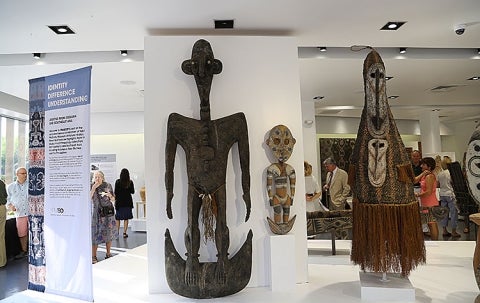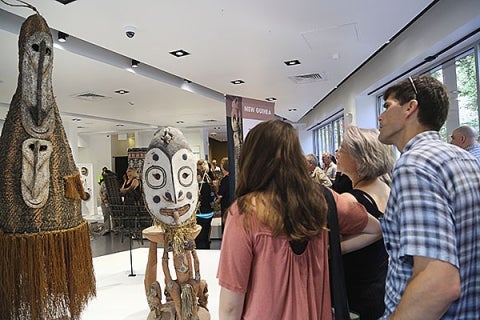Note: Yale School of the Environment (YSE) was formerly known as the Yale School of Forestry & Environmental Studies (F&ES). News articles and events posted prior to July 1, 2020 refer to the School's name at that time.

Students returning to campus this week will notice a new museum — Peabody2 — in what had been retail space at 1 Broadway. Where shoppers previously purchased designer clothing, visitors can now view aboriginal and ethnographic art from Australia, Indonesia, New Guinea, and the Philippines.
The exhibit, entitled “Identity, Difference, and Understanding: Lessons from Oceania and Southeast Asia,” and curated by F&ES Prof. Michael Dove, is free and open to the public Monday through Saturday from 10 a.m. to 9 p.m., and Sunday from noon to 6 p.m.
The gallery is an offshoot of Yale’s Peabody Museum of Natural History, which is celebrating its 150th anniversary this year.
The exhibit, entitled “Identity, Difference, and Understanding: Lessons from Oceania and Southeast Asia,” and curated by F&ES Prof. Michael Dove, is free and open to the public Monday through Saturday from 10 a.m. to 9 p.m., and Sunday from noon to 6 p.m.
The gallery is an offshoot of Yale’s Peabody Museum of Natural History, which is celebrating its 150th anniversary this year.

Dove, an anthropologist and professor of social ecology and chair of Yale’s Council on Southeast Asian Studies, says he wanted the exhibit to engage the Yale community in relevant conversations on topics such as cultural, ethnic, and racial difference.
“From the beginning, I was thinking that the debates and discussions on campus over the past year about race, ethnicity, identity — and how we talk about them — was an unavoidable context for this exhibit,” he said in a recent interview.
Dove says the exhibit also reflects renewed interest by anthropologists in material objects. These objects, he says, address fundamental questions about what it means to be human, what is human society, and what is culture. “These are questions percolating not just on the Yale campus, but in the wider country,” Dove said. “They are important questions for the Peabody to engage with.”
Organizers hope the exhibit, located in The Shops at Yale at the corner of Broadway and York streets, will reach beyond the usual Peabody audience. It also sparks questions about the changing mission of museums in the 21st century.
“In the past we would have presented these objects from the Peabody collection in part for their aesthetic appeal, and cross-cultural universals are definitely interesting to study,” Dove said. “But here we try and push beyond that and interrogate what a museum is all about by asking: what are we asking the viewer to ask, what are you looking at here, why was it made, and equally important, why was it collected?”
“From the beginning, I was thinking that the debates and discussions on campus over the past year about race, ethnicity, identity — and how we talk about them — was an unavoidable context for this exhibit,” he said in a recent interview.
Dove says the exhibit also reflects renewed interest by anthropologists in material objects. These objects, he says, address fundamental questions about what it means to be human, what is human society, and what is culture. “These are questions percolating not just on the Yale campus, but in the wider country,” Dove said. “They are important questions for the Peabody to engage with.”
Organizers hope the exhibit, located in The Shops at Yale at the corner of Broadway and York streets, will reach beyond the usual Peabody audience. It also sparks questions about the changing mission of museums in the 21st century.
“In the past we would have presented these objects from the Peabody collection in part for their aesthetic appeal, and cross-cultural universals are definitely interesting to study,” Dove said. “But here we try and push beyond that and interrogate what a museum is all about by asking: what are we asking the viewer to ask, what are you looking at here, why was it made, and equally important, why was it collected?”
When we’re looking at these things, we’re looking at things that were already made for others’ eyes. It’s almost like looking in the mirror.
Many of the objects in the exhibit belong to categories of material things that would have been involved in local trade. And this trade would’ve affected how things were made. “When we’re looking at these things, we’re looking at things that were already made for others’ eyes. It’s almost like looking in the mirror. We’re looking, in some cases, at things made for us,” Dove said.
This complicates the way we see the world, and that, he says, is part of the over-arching objective of the exhibit. “It can show these connections, how we and very distant peoples are engaged. It can problematize our commonsense understandings of self and other, of the familiar and the different. And so help to add a voice to these discussions that began on Yale campus this past year.”
The gallery will host events throughout the year, such as speakers and musical performances, and at least one pan-Asian student organization is planning to hold their freshman orientation in the space.
The exhibit will be open through April 2017.
This complicates the way we see the world, and that, he says, is part of the over-arching objective of the exhibit. “It can show these connections, how we and very distant peoples are engaged. It can problematize our commonsense understandings of self and other, of the familiar and the different. And so help to add a voice to these discussions that began on Yale campus this past year.”
The gallery will host events throughout the year, such as speakers and musical performances, and at least one pan-Asian student organization is planning to hold their freshman orientation in the space.
The exhibit will be open through April 2017.
– Timothy Brown timothy.brown@yale.edu
Published
August 31, 2016